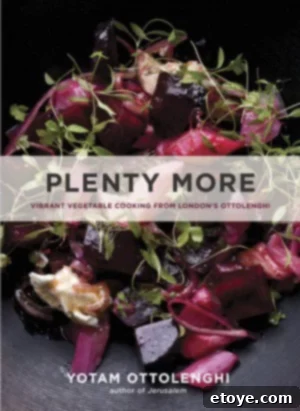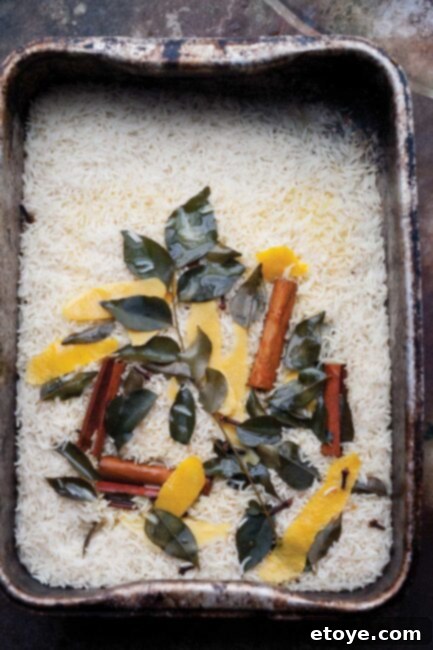
Experience Exquisite Flavors: Baked Lemon, Cinnamon, and Curry Leaf Basmati Rice
Transform your ordinary rice dishes into an extraordinary culinary experience with this unique recipe for Lemon, Cinnamon, and Curry Leaf Basmati Rice. Inspired by the masterful culinary creations of award-winning chef Yotam Ottolenghi, this dish elevates simple basmati rice into a symphony of fragrant aromas and vibrant flavors. Far from a mere side dish, this baked rice offers a stunning presentation and a depth of taste that will impress even the most discerning palates. Whether you’re a seasoned chef or a home cook looking to explore new horizons, this recipe provides a foolproof method to achieve perfectly cooked, aromatic rice that stands out.
- Infuse plain basmati rice with the captivating aromas of cinnamon, fresh curry leaves, and bright lemon.
- Achieve a sophisticated presentation with rice baked to perfection in a pan.
- Discover the versatility of this technique, allowing for endless customization with your preferred spices and herbs.
- Enjoy a remarkable recipe from the celebrated chef, Yotam Ottolenghi, known for his innovative approach to vegetable-centric cooking.
The Joy of Culinary Inspiration: A Mother’s Love for Cookbooks
Just last week, my parents graced us with their presence for a few delightful days. Escaping the vibrant, yet often hectic, pace of Las Vegas where they reside, they came to relax, spend time with family, and, much to my delight, cook for me. My mother, in particular, possesses an encyclopedic passion for cookbooks, boasting an entire room in their house dedicated to her magnificent collection. From rare culinary tomes to modern gastronomic guides, her shelves are a testament to her lifelong love affair with food and recipes.
During their visit, I extended what I considered one of the greatest gifts I could bestow upon my mother: unrestricted access to my own extensive collection of cookbooks. Many of these I’ve accumulated over the years, often arriving directly from publishers eager to showcase their latest releases. “You may have any of my cookbooks – take as many as you’d like!” I declared, watching her eyes light up with pure joy. It was a gesture born from understanding her deep appreciation for the art of cooking and the stories held within those pages.
My mother, with an almost childlike glee, spent hours meticulously going through my bookshelves. She’d carefully slide each cookbook out, flip through its pages, savoring the photographs and recipes, before deciding which ones would join her esteemed collection. Cooking and cookbooks are more than just hobbies for her; they are a source of comfort, creativity, and connection. I deliberately avoided peeking, refrained from declaring any books off-limits, and didn’t even attempt to hide my personal favorites. Her happiness was paramount. She was absolutely thrilled with her selections and even sent me a photo of her treasured haul once she returned home, a visual confirmation of her successful literary raid.
It wasn’t until today, as I began to draft this very article, that a moment of panic struck me. A thought, unsettling and immediate, flashed through my mind: “What if she took ‘Plenty More Cookbook’?” My heart momentarily sank at the prospect. I confess, I raced back to my bookshelves, scanning them with a frantic energy. My first pass yielded no sign of it, sending a wave of genuine dismay through me. But then, on my second, more thorough glance, there it was, sitting safe and sound exactly where it belonged. “Whew!” A sigh of relief escaped me, proving just how much this particular cookbook means to me.

Why ‘Plenty More’ Resonates with Home Cooks and Culinary Experts Alike
I am certainly not alone in my profound admiration for this book. Plenty More: Vibrant Vegetable Cooking from London’s Ottolenghi received a well-deserved nomination as a finalist in the prestigious James Beard Awards. This recognition is a testament to its exceptional quality and innovative approach. The book features an impressive collection of 150 recipes, all centered around vegetables, showcasing how to elevate them beyond simple braising, boiling, or baking. Each recipe is accompanied by stunning, earthy photographs that not only inspire but also highlight creative cooking techniques, making vegetables the undisputed stars of the plate. Chef Yotam Ottolenghi has a remarkable talent for combining diverse ingredients and flavors, transforming everyday vegetables into extraordinary dishes. His philosophy encourages a fresh perspective on plant-based cooking, demonstrating that vegetables can be incredibly satisfying, complex, and full of character.

My deep affection for the Plenty More Cookbook stems from its ability to inspire and challenge my cooking. It pushes me to experiment with ingredients I might not typically consider, and its recipes consistently deliver incredible results. It’s a treasure trove of culinary wisdom that has significantly influenced my own kitchen adventures. That’s why we are so incredibly excited to share with you a standout recipe from this acclaimed book: the Lemon, Cinnamon, and Curry Leaf Rice.
The Art of Baking Rice: Unlocking Deeper Flavors
Despite having an array of convenient gadgets at my disposal for cooking rice – from mastering how to cook perfect rice in the microwave to utilizing my high-tech Zojirushi Rice Cooker – I surprisingly rarely turn to the method of baking rice. This is a considerable oversight, as the baking technique yields truly superior results. Baking rice ensures a more even cook, producing grains that are beautifully separated, tender, and consistently cooked through. Furthermore, it imparts a wonderfully nutty and more pronounced flavor to the rice, especially when infused with aromatic ingredients. As Ottolenghi himself notes, when you combine this baking method with fragrant elements like fresh lemon, cinnamon sticks, and vibrant curry leaves, “this will be a revelation.” The dry heat of the oven, combined with the slow absorption of the liquid, creates a texture and depth of flavor that steaming or boiling often cannot match. It’s a method that promises to transform your perception of what a simple rice dish can be.
Discovering the Allure of Curry Leaf
What Exactly is a Curry Leaf?
Curry leaves are the aromatic foliage of the curry tree, a plant native to South Asia. These leaves are a staple ingredient in the culinary traditions of Southern India, Sri Lanka, Cambodia, and Malaysia, prized for their complex and uniquely pungent lemon-like flavor. Unlike curry powder, which is a blend of various spices, curry leaves are used whole, either fresh or frozen, to impart their distinctive essence. Just a few leaves are enough to infuse an entire dish with their deeply aromatic profile. They are most commonly associated with Indian curries, hence their name, but their versatility extends to stir-fries, tempering, and a myriad of other savory preparations.
Sourcing and Storing Fresh Curry Leaves
We once had a thriving curry tree in our old garden, but sadly, it perished after being neglected in a forgotten corner. These days, when I require fresh curry leaves, my go-to destination is a local Indian grocery store. These specialty markets are the most reliable source for fresh, vibrant leaves. If fresh leaves are unavailable, don’t despair; many stores offer them frozen, which is an excellent alternative. Curry leaves freeze exceptionally well, retaining their flavor profile beautifully. If you purchase a large bunch, feel free to freeze any unused portion. While the leaves may darken slightly in color when frozen, their potent aroma and taste will remain perfectly preserved, ready to elevate your next culinary creation.
Further Exploration of Curry Leaves
- Indian Fish Coconut Curry – Steamy Kitchen
- NPR: Fresh Curry Leaves add a Touch of India
- Food 52: How to Buy and Use Curry Leaves
- Chana Masala Recipe – Veg Recipes of India
- Malaysian Chicken Curry – BBC Food
- Traditional Cambodian Seafood Curry – Taste
What if Curry Leaves Aren’t Available?
No problem at all! While the unique essence of curry leaves is a signature component of this recipe, the beauty of this baked rice technique lies in its adaptability. You can absolutely substitute with any herb you love, allowing you to tailor the flavor profile to your personal preference or what you have readily available. Consider fresh basil for a vibrant, peppery note, parsley for a clean, herbaceous touch, or bay leaves for a more subtle, earthy aroma. Other excellent options include sage for a warm, savory undertone, oregano for a Mediterranean twist, cilantro for a fresh, citrusy zing, or dill for a delicate, anise-like flavor. Of course, the resulting taste will differ from the original intended recipe, but the core cooking method remains the same, ensuring a delicious and aromatic rice dish no matter your herb choice. Experiment and discover your own favorite aromatic combinations!
Delving Deeper: Yotam Ottolenghi and ‘Plenty More’
Yotam Ottolenghi is a celebrated Israeli-British chef, restaurateur, and cookbook author who has profoundly influenced modern cuisine, particularly with his emphasis on vegetable-centric dishes. His restaurants in London are renowned for their vibrant, fresh, and innovative food, showcasing bold flavors and Middle Eastern influences. ‘Plenty More’ is one of his most beloved cookbooks, following the success of ‘Plenty.’ It further explores the vast potential of vegetables, encouraging home cooks to embrace a more plant-forward diet with exciting and accessible recipes. His work is characterized by unique flavor combinations, often incorporating spices, herbs, and textures from diverse culinary traditions.
- NPR’s Interview with Yotam Ottolenghi
- James Beard 2015 Award Finalists
Plenty More: Vibrant Vegetable Cooking from London’s Ottolenghi is more than just a cookbook; it’s an invitation to explore a world of rich flavors and inventive cooking. It’s a book that has truly earned its place on my coveted shelf, and I highly recommend it to anyone looking to expand their culinary repertoire and fall in love with vegetables all over again.
Lemon, Cinnamon and Curry Leaf Basmati Rice Recipe
Prepare for a culinary revelation that will change your perspective on plain steamed basmati. This method is incredibly reliable, and the outcome is nothing short of spectacular. This fragrant rice can serve as a delightful vegetarian meal when paired with an Asian savory pickle, or as an exquisite accompaniment to freshly roasted chicken. For the best results, seek out fresh curry leaves and use them directly on the stem. Don’t worry if you acquire a large bunch; curry leaves freeze beautifully, preserving their intense flavor for future dishes.
Prep Time: 5 mins
Cook Time: 40 mins
Servings: 4
Ingredients
- 5 short cinnamon sticks
- 10 whole cloves
- 1 lemon
- 3 stems fresh curry leaves (approximately 25 leaves)
- 2 cups basmati rice
- 1/4 cup unsalted butter
- Salt and pepper to taste
Instructions
Prep:
In a large bowl, add the basmati rice. Fill the bowl with water, gently swish the rice around, then carefully drain the water (you can use your hands to cup the rice and prevent it from spilling out). Repeat this rinsing process once more. After the second rinse, fill the bowl with fresh water again and let the rice soak for 15 minutes.
While the rice is soaking, preheat your oven to 400°F (200°C). Using a vegetable peeler, carefully peel the rind off the lemon in large strips, ensuring you only take the yellow zest and avoid the bitter white pith. Cut the lemon in half and squeeze out 1 tablespoon of the fresh lemon juice, setting it aside for later.
Cook:
Place the cinnamon sticks, whole cloves, lemon rind strips, fresh curry leaves, 1-1/2 teaspoons of salt, and 1/2 teaspoon of black pepper into a saucepan. Add 2-3/4 cups of water and place the saucepan over high heat. As soon as the water reaches a rolling boil, immediately remove the pan from the heat.
Evenly spread the soaked and drained basmati rice in a baking dish or roasting pan, approximately 9-1/2 by 12 inches in size. Carefully pour the hot, aromatic water from the saucepan over the rice, along with all the spices and aromatics. Stir everything together gently but thoroughly to combine. Lay a piece of waxed paper directly over the surface of the water and rice, then cover the entire dish tightly with aluminum foil. Place the dish in the preheated oven and cook for 25 minutes. After 25 minutes, remove the dish from the oven but leave it covered to rest for an additional 8 to 10 minutes.
Just before you’re ready to serve, melt the unsalted butter in a small saucepan over low heat. Once the butter is completely melted and very hot, carefully add the reserved 1 tablespoon of lemon juice. Swirl the pan gently to mix the butter and lemon juice together. Pour this hot lemon-butter mixture evenly over the cooked rice. Using a fork, fluff up the rice to separate the grains and distribute the flavors. Transfer the fragrant rice to a serving bowl and serve immediately. You can choose to remove the curry stems and cinnamon sticks before serving, or leave them in for a beautiful presentation.
Notes
Reprinted with permission from Plenty More: Vibrant Vegetable Cooking from London’s Ottolenghi, copyright © 2014. Published by Ten Speed Press, an imprint of Random House LLC. Photography credit: Jonathan Lovekin © 2014.
Share Your Culinary Journey!
Have you tried this incredible Lemon, Cinnamon, and Curry Leaf Basmati Rice recipe? We would love to hear about your experience! Your feedback and cooking adventures inspire us and the entire culinary community. Please share your thoughts, tips, and any variations you tried in the comments section below. Let us know how it was!
